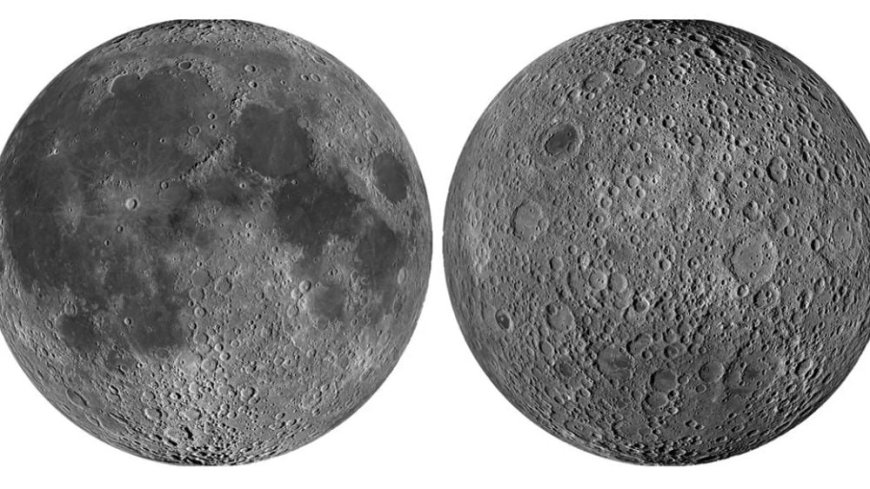Why the Moon's Two Sides Look Different: The Role of Certain Minerals
In 1959, Luna 3 spacecraft revealed the lunar farside's unique features. New research in Nature Communications suggests that trace minerals like chlorine and fluorine could explain the Moon's dichotomy. The study explores how these minerals affect lunar crust formation and metasomatism processes.

Up until 1959, humans had never laid eyes on the lunar farside. In that year, the USSR's Luna 3 spacecraft flew around the Moon and sent pictures of the farside back to Earth. Though the images were grainy and black and white, they were still revealing. They showed us that the farside was different. It has more craters and fewer of the dark volcanic plains, called 'maria', that characterize the near side.
The contrast between the two sides immediately raised questions about how the Moon formed and evolved. Scientists wondered if Earth's gravitational influence was responsible, or if the thickness of the crust was different. Scientists realized that the Moon wasn't a uniform body, and they've been puzzling over the cause ever since.
This historic photo of the lunar farside was taken by Luna 3 on October 7th, 1959. The Soviet spacecraft gave humanity our first look at the other side of the Moon, revealing a more cratered surface with fewer dark volcanic plains. Image Credit: Public Domain.
A new research article in Nature Communications shows how trace amounts of some minerals could explain the lunar dichotomy. It's titled \"Halogen abundance evidence for the formation and metasomatism of the primary lunar crust.\" The lead author is Jie-Jun Jing from the Geodynamics Research Center at Ehime University in Japan.
It's focused on chlorine (Cl) and fluorine (F) and their presence in minerals and melts on the Moon. \"Halogen abundances in lunar minerals provide unique insight into the Moon’s volatile budget, but incomplete knowledge of halogen incorporation in minerals and melts limits their application,\" the authors write. \"Most nearside lunar crust materials turn out to be anomalously enriched in Cl compared to expectations from primary crust formation models, likely due to widespread (metal chloride) metasomatism.\"
Metasomatism is a geological process where rock's chemical composition is altered when new chemical elements are introduced by water or magma.
Around 4.5 billion years ago, the Moon was covered by a global magma ocean. The solidification of the Moon is expected to produce a plagioclase-rich crust. This only appears in the farside of the Moon, whereas the nearside Moon is largely covered by dark erupted basalts. Image Credit: Jiejun Jing
The researchers performed lab experiments mimicking how Cl distributed itself in lunar magma and minerals via metasomatism. They also worked with models of the evolution of the Moon's interior and coupled them with the halogen abundances found in lunar samples. They found that while nearside samples are anomalously abundant in Cl, farside samples are not. They say that this is a result of metasomatism where gaseous Cl-compounds found their way into lunar nearside rocks.
Another piece of the lunar puzzle is the Moon's KREEP terrane. It's a large region on the Moon's nearside with abundant potassium (K), rare Earth elements (REE) and phosphorous (P). Of the four lunar terranes, KREEP is the only one that is found exclusively on the Moon's nearside. It's also known for its high concentrations of thorium.
This figure shows thorium concentrations on the Moon. The large area of high concentration on the Near Side (left) corresponds to the Procellarum KREEP Terrane, and the smaller area on the Far Side (right) to the South Pole–Aitken Terrane. Image Credit: By NASA - http://solarsystem.nasa.gov/multimedia/display.cfm?Category=Planets&IM_ID=13643, Public Domain
KREEP is crucial to how the Moon formed and evolved after its magma ocean phase. While KREEP was likely widespread around the Moon in its earliest stages, it's now confined to one region. Researchers aren't certain why, it could be because of the massive impact that excavated the South Pole Aitken (SPA) basin. That's on the opposite side of the Moon and that impact could've created a thermal anomaly that drove the KREEP towards the nearside where it's found now.
The research shows that Cl vapour was widespread on the lunar nearside, but not on the farside. This suggests a strong connection between it and the lunar dichotomy.
The researchers think that the Cl metasomatism may be related to degassing by impact or eruption from the KREEP terrane. Cl is highly volatile and incompatible. In the geological context, this means that Cl doesn't easily fit into the crystal structure of minerals while magma is cooling and becoming solid.
\"Chlorine-rich vapors released during eruptions (or impact-induced evaporation) played a key role in transforming the Moon’s nearside that human can see,\" the authors explain. On the other hand, they hypothesize that the farside is untouched by these vapour-related volcanic activities. It's more pristine than the nearside, and preserves information from the Moon's magma ocean phase.
This research could explain the lunar dichotomy but the authors point out that more evidence is needed. China has landed two missions on the lunar farside, including the Chang'e-6 mission which gathered samples. According to the authors, lunar farside missions could provide the evidence needed to strengthen their explanation.
\"The hypothesis that Cl metasomatism is limited to the Procellarum KREEP terrane can be further tested by combining our experimental data with halogen measurements of farside Chang’e-6 samples,\" they conclude.
What's Your Reaction?
 Like
0
Like
0
 Dislike
0
Dislike
0
 Love
0
Love
0
 Funny
0
Funny
0
 Angry
0
Angry
0
 Sad
0
Sad
0
 Wow
0
Wow
0





















































































































































